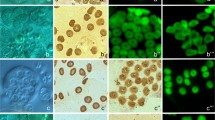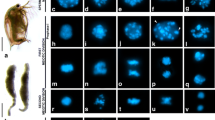Abstract
Naturally occurring heavy metals and synthetic compounds are potentially harmful for testicular function but evidence linking heavy metal exposure to reduced semen parameters is inconclusive. Elucidation of the exact stage at which the toxicant interferes with spermatogenesis is difficult because the various germ cell stages may have different sensitivities to any given toxicant, germ cell development is influenced by supporting testicular somatic cells and the presence of inter-Sertoli cell tight junctions create a blood-testis barrier, sequestering meiotic and postmeiotic germ cells in a special microenvironment. Sharks such as Squalus acanthias provide a suitable model for studying aspects of vertebrate spermatogenosis because of their unique features: spermatogenesis takes place within spermatocysts and relies mainly on Sertoli cells for somatic cell support; spermatocysts are linearly arranged in a maturational order across the diameter of the elongated testis; spermatocysts containing germ cells at different stages of development are topographically separated, resulting in visible zonation in testicular cross sections. We have used the vital dye acridine orange and a novel fluorescence staining technique to study this model to determine (1) the efficacy of these methods in assays of apoptosis and blood-testis barrier function, (2) the sensitivity of the various spermatogonial generations in Squalus to cadmium (as an illustrative spermatotoxicant) and (3) the way that cadmium might affect more mature spermatogenic stages and other physiological processes in the testis. Our results show that cadmium targets early spermatogenic stages, where it specifically activates a cell death program in susceptible (mature) spermatogonial clones, and negatively affects blood-testis barrier function. Since other parameters are relatively unaffected by cadmium, the effects of this toxicant on apoptosis are presumably process-specific and not attributable to general toxicity.








Similar content being viewed by others
References
Abrams JM, White K, Fessler I (1993) Programmed cell death during Drosophila embryogenesis. Development 117:29–43
Banfalvi G, Gacsi M, Nagy G, Kiss ZB, Basnakian AG (2005) Cadmium induced apoptotic changes in chromatin structure and subphases of nuclear growth during the cell cycle in CHO cells. Apoptosis 10:631–642
Bergmann M, Schindelmeiser J, Greven H (1984) The blood-testis barrier in vertebrates having different testicular organization. Cell Tissue Res 238:145–150
Betka M, Callard GV (1999) Stage-dependent accumulation of cadmium and induction of metallothionein-like binding activity in the testis of the dogfish shark, Squalus acanthias. Biol Reprod 60:14–22
Broaddus VC, Yang L, Scavo LM, Ernst JD, Boylan AM (1996) Asbestos induces apoptosis of human and rabbit pleural mesothelial cells via reactive oxygen species. J Clin Invest 98:1–10
Callard GV, Pudney JA, Mak P, Canick J (1985) Stage-dependent changes in steroidogenic enzymes and estrogen receptors during spermatogenesis in the testis of the dogfish Squalus acanthias. Endocrinology 117:1328–1335
Callard GV, Jorgensen JC, Redding JM (1995) Biochemical analysis of programmed cell death during premeiotic stages of spermatogenesis in vivo and in vitro. Dev Gen 16:140–147
Chia SE, Ong CN, Lee ST, Tsakok FH (1992) Blood concentrations of lead, cadmium, mercury, zinc, and copper and human semen parameters. Arch Androl 29:177–183
Chiqouine AD, Suntzeff V (1965) Sensitivity of mammals to cadmium necrosis of the testis. J Reprod Fertil 10:455–457
Choe S, Kim S, Kim H, Lee JH, Choi Y, Lee H, Kim Y (2003) Evaluation of estrogenicity of major heavy metals. Sci Tot Environ 312:15–21
Chung NPY, Cheng CY (2001) Is cadmium chloride-induced inter-Sertoli tight junction permeability barrier disruption a suitable in vitro model to study the events of junction disassembly during spermatogenesis in the rat testis? Endocrinology 142:1878–1888
Cuevas ME, Callard GV (1992) Androgen and progesterone receptors in shark (Squalus) testis: characteristics and stage-related distribution. Endocrinology 130:2173–2182
Degraeve N (1981) Carcinogenic, teratogenic and mutagenic effects of cadmium. Mut Res 86:115–135
Din WS, Frazier JM (1985) Protective effect of metallothionein on cadmium toxicity in isolated rat hepatocytes. Biochem J 230:395–402
Dobson S, Dodd JM (1977) Endocrine control of the testis in the dogfish Scyliorhinus canicula L. II. Histological and ultrastructural changes in the testis after partial hypophysectomy (ventral lobectomy). Gen Comp Endocrinol 32:53–71
DuBois W, Callard GV (1991) Culture of intact Sertoli/germ cells units and isolated Sertoli cells from Squalus testis. I. Evidence of stage-related functions in vitro. J Exp Zool 258:359–372
DuBois W, Callard GV (1993) Culture of intact Sertoli/germ cell units and isolated Sertoli cells from Squalus testis. II. Stimulatory effects of insulin and IGF-I on DNA synthesis in premeiotic stages. J Exp Zool 267:233–244
Durrieu F, Belloc F, Lacoste L, Dumain P, Chabrol J, Dachary-Prigent J, Morjani H, Boisseau MR, Reiffers J, Bernard P, Lacombe F (1998) Caspase activation is an early event in anthracycline-induced apoptosis and allows detection of apoptotic cells before they are ingested by phagocytes. Exp Cell Res 240:165–175
Dym M, Fawcett DW (1970) The blood-testis barrier in the rat and the physiological compartmentation of the seminiferous epithelium. Biol Reprod 3:308–326
Grima J, Wong CC, Zhu LJ, Zong SD, Cheng CY (1998) Testin secreted by Sertoli cells is associated with the cell surface, and its expression correlates with the disruption of Sertoli-germ cell junctions but not the inter-Sertoli tight junction. J Biol Chem 273:21040–21053
Gupta RS, Kim J, Gomes C, Oh S, Park J, Seong JY, Ahn RS, Kwon H, Soh J (2004) Effect of ascorbic acid supplementation on testicular steroidogenesis and germ cell cell death in cadmium-treated male rats. Mol Cell Endocrinol 221:57–66
Hamada T, Tanimoto A, Iwai S, Fujiwara H, Sasaguri Y (1994) Cytopathological changes induced by cadmium-exposure in canine proximal tubular cells: a cytochemical and ultrastructural study. Nephron 68:104–111
Hechtenberg S, Schafer T, Benters J, Beyersmann D (1996) Effects of cadmium on cellular calcium and proto-oncogene expression. Ann Clin Lab Sci 26:512–521
Hew KW, Heath GL, Jiwa AH, Welsh MJ (1993a) Cadmium in vivo causes disruption of tight junction-associated microfilaments in rat Sertoli cells. Biol Reprod 49:840–849
Hew KW, Ericson WA, Welsh MJ (1993b) A single low cadmium dose causes failure of spermiation in the rat. Toxicol Appl Pharmacol 121:15–21
Hjollund NHI, Bonde JPE, Jensen TK, Ernst E, Henriksen TB, Kolstad HA, Giwercman A, Skakkebaek NE, Olsen J (1998) Semen quality and sex hormones with reference to metal welding. Reprod Toxicol 12:91–95
Jégou B, Pineau C, Vélez de la Calle J, Bardin W, Touzalain AM, Cheng CY (1992) Germ cell control on testin production is inverse to that of other Sertoli cell parameters. Endocrinology 132:2557–2562
Loir M, Sourdaine P, Mendis-Handagama SMLC, Jégou B (1995) Cell-cell interactions in the testis of teleosts and elasmobranchs. Microsc Res Tech 32:533–552
Lowry OH, Rosebrough NJ, Farr AL, Randall RJ (1951) Protein measurement with the Folin phenol reagent. J Biol Chem 193:265–275
Majno G, Joris I (1995) Apoptosis, oncosis, and necrosis. Am J Pathol 146:3–15
McClusky LM (2005) Stage and season effects on cell cycle and apoptotic activities of germ cells and Sertoli cells during spermatogenesis in the spiny dogfish (Squalus acanthias). Reproduction 129:89–102
Oldereid NB, Thomassen Y, Attramadal A, Olaisen B, Purvis K (1993) Concentrations of lead, cadmium and zinc in the tissues of reproductive organs of men. J Reprod Fertil 99:421–442
Ortego LS, Hawkins WE, Walker WW, Kroll RM, Benson WH (1994) Detection of proliferating cell nuclear antigen in tissues of three small fish species. Biotech Histochem 69:317–323
Ozawa N, Goda N, Makino N, Yamaguchi T, Yoshimura Y, Suematsu M (2002) Leydig cell-derived heme oxygenase-1 regulates apoptosis of premeiotic germ cells in response to stress. J Clin Invest 109:457–467
Parvinen M (1982) Regulation of the seminiferous epithelium. Endocr Rev 3:404–417
Pudney J, Callard GV (1984) Identification of Leydig-like cells in the interstitium of the shark testis (Squalus acanthias). Anat Rec 209:311–330
Setchell BP, Waites GMH (1970) Changes in the permeability of the testicular capillaries and of the “blood testis barrier” after injection of cadmium chloride in the rat. J Endocrinol 47:81–86
Sever LE (1997) Epidemiologic evidence for toxic effects of occupational and environmental chemicals on the testes. In: Thomas JA, Colby HD (eds) Endocrine toxicology, 2nd edn. Taylor and Francis, Washington London, pp 287–326
Simpson TH, Wardle CS (1967) A seasonal cycle in the testis of the spurdog, Squalus acanthias, and the sites of 3β-hydroxysteroid dehydrogenase activity. J Mar Biol Assoc UK 47:699–708
Sinha Hikim AP, Lue Y, Swerdloff RS (1997) Separation of germ cell apoptosis from toxin-induced cell death by necrosis using in situ-labelling histochemistry after glutaraldehyde fixation. Tissue Cell 29:487–493
Snow ET (1992) Metal carcinogenesis: mechanistic implications. Pharmacol Ther 53:31–65
Sundaram K, Witorsch RJ (1995) Toxic effects on the testes. In: Witorsch RJ (ed) Reproductive toxicology. Raven, New York, pp 99–224
Vetillard A, Bailhache T (2005) Cadmium: an endocrine disrupter that affects gene expression in the liver and brain of juvenile rainbow trout. Biol Reprod 72:119–126
Wong K-L, Klaassen CD (1980) Age difference in the testicular susceptibility to cadmium-induced testicular damage in rats. Toxicol Appl Pharmacol 55:456–466
Xu C, Johnson JE, Singh PK, Jones MM, Yan H, Carter CE (1996) In vivo studies of cadmium-induced apoptosis in testicular tissue of the rat and its modulation by a chelating agent. Toxicology 107:1–8
Acknowledgements
A word of thanks to Drs. Gloria Callard and Jeffrey Pudney for helpful discussions and a special word of appreciation to Drs. David Miller and Marlies Betka for excellent technical assistance with the fluorescence microscopy, and dissections and cyst preparations, respectively.
Author information
Authors and Affiliations
Corresponding author
Additional information
This study was mainly carried out during summer fellowships at the Mount Desert Island Biological Laboratory, Salsbury Cove, Maine, USA, and partly with financial support from the National Research Foundation of South Africa.
Rights and permissions
About this article
Cite this article
McClusky, L.M. Stage-dependency of apoptosis and the blood-testis barrier in the dogfish shark (Squalus acanthias): cadmium-induced changes as assessed by vital fluorescence techniques. Cell Tissue Res 325, 541–553 (2006). https://doi.org/10.1007/s00441-006-0184-6
Received:
Accepted:
Published:
Issue Date:
DOI: https://doi.org/10.1007/s00441-006-0184-6




